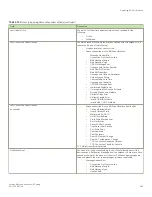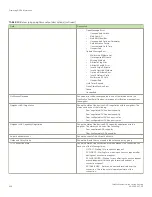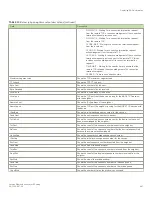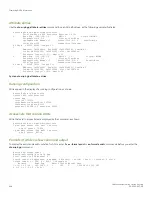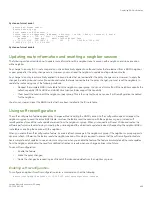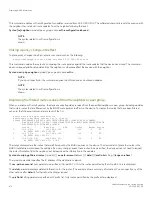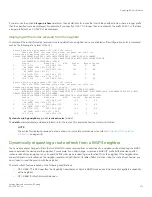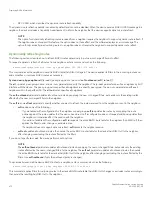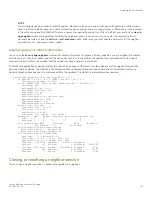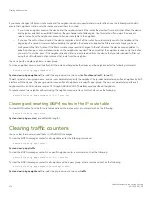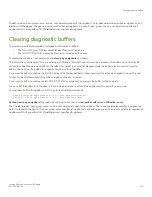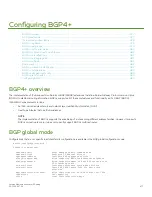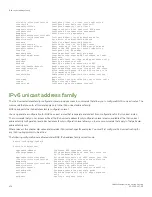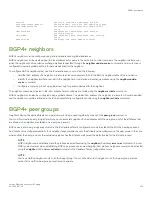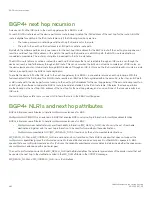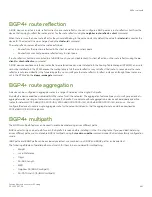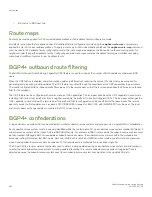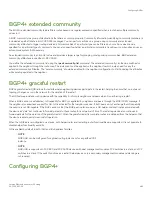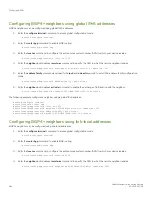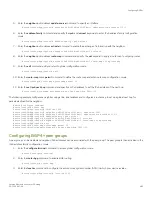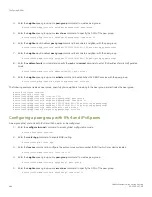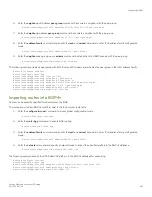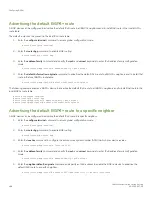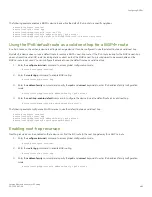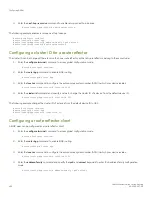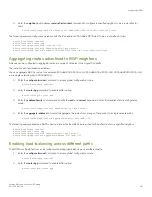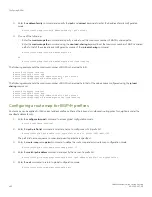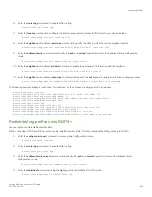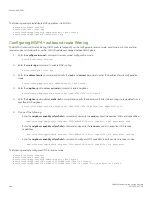
network Specify a network to announce via BGP
next-hop-enable-default Enable default route for BGP next-hop lookup
next-hop-recursion Perform next-hop recursive lookup for BGP
route
redistribute Redistribute information from another
routing protocol
table-map Map external entry attributes into routing
table
update-time Configure igp route update interval
BGP4+ neighbors
BGP4+ neighbors can be configured using link-local addresses or global addresses.
BGP4+ neighbors can be created using link-local addresses for peers in the same link. For link-local peers, the neighbor interface over
which the neighbor and local device exchange prefixes is specified through the
neighbor update-source
command, and a route map is
configured to set up a global next hop for packets destined for the neighbor.
To configure BGP4+ neighbors that use link-local addresses, you must do the following:
•
Add the IPv6 address of a neighbor in a remote autonomous system (AS) to the BGP4+ neighbor table of the local device.
•
Identify the neighbor interface over which the neighbor and local device will exchange prefixes using the
neighbor update-
source
command.
•
Configure a route map to set up a global next hop for packets destined for the neighbor.
The neighbor should be activated in the IPv6 address family configuration mode using the
neighbor activate
command.
BGP4+ neighbors can also be configured using a global address. The global IPv6 address of a neighbor in a remote AS must be added,
and the neighbor should be activated in the IPv6 address family configuration mode using the
neighbor activate
command.
BGP4+ peer groups
Neighbors having the same attributes and parameters can be grouped together by means of the
peer-group
command.
You must first create a peer group, after which you can associate neighbor IPv6 addresses with the peer group. All of the attributes that
are allowed on a neighbor are allowed on a peer group as well.
BGP4+ peers and peer groups are activated in the IPv6 address family configuration mode to establish the BGP4+ peering sessions.
An attribute value configured explicitly for a neighbor takes precedence over the attribute value configured on the peer group. In the case
where neither the peer group nor the individual neighbor has the attribute configured, the default value for the attribute is used.
NOTE
BGP4 neighbors are established and the prefixes are advertised using the
neighbor
IP address
remote-as
command in router
BGP mode. However, when establishing BGP4+ peer sessions and exchanging IPv6 prefixes, neighbors must also be activated
using the
neighbor
IPv6 address
activate
command in IPv6 address family configuration mode.
NOTE
You can add IPv6 neighbors only to an IPv6 peer group. You cannot add an IPv4 neighbor to an IPv6 peer group and vice
versa. IPv4 and IPv6 peer groups must remain separate.
BGP4+ peer groups
FastIron Ethernet Switch Layer 3 Routing
53-1003627-04
479
Summary of Contents for FastIron SX 1600
Page 2: ...FastIron Ethernet Switch Layer 3 Routing 2 53 1003627 04 ...
Page 16: ...FastIron Ethernet Switch Layer 3 Routing 16 53 1003627 04 ...
Page 20: ...FastIron Ethernet Switch Layer 3 Routing 20 53 1003627 04 ...
Page 142: ...FastIron Ethernet Switch Layer 3 Routing 142 53 1003627 04 ...
Page 150: ...FastIron Ethernet Switch Layer 3 Routing 150 53 1003627 04 ...
Page 200: ...FastIron Ethernet Switch Layer 3 Routing 200 53 1003627 04 ...
Page 214: ...FastIron Ethernet Switch Layer 3 Routing 214 53 1003627 04 ...
Page 350: ...FastIron Ethernet Switch Layer 3 Routing 350 53 1003627 04 ...
Page 476: ...FastIron Ethernet Switch Layer 3 Routing 476 53 1003627 04 ...
Page 588: ...FastIron Ethernet Switch Layer 3 Routing 588 53 1003627 04 ...

